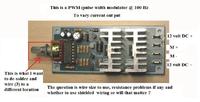EnergyGuy
Newbie level 2
hho control box

I have a PWM to control the current for a 12volt DC hydrogen generator up to 30 amps.
The PWM has a 10K variable pot on the board with three connection points (soldered to board) I want to remove this pot and wire it inside the vehicle and leave the board under the hood where I can put a heat sink and fan on it to cool it. I will be running it at from 15-20 amps but as the generator heats up so will the current draw go up so I want to be able to reduce it from inside the vehicle. Can I use plain 22 gauge wire twisted or shielded? Not sure about the resistance increase either or gauge of wire to use. The wiring and pot will be approximately 8 feet from the board (physically about 5 feet but to route it around and to the control box I’ll put it inm, it will be about 8-10 feet of 3 wires).
Thanks
Not sure If I did this correctly in putting the image in the body so I added it as attachment too. It is self explanatory. [/img]

I have a PWM to control the current for a 12volt DC hydrogen generator up to 30 amps.
The PWM has a 10K variable pot on the board with three connection points (soldered to board) I want to remove this pot and wire it inside the vehicle and leave the board under the hood where I can put a heat sink and fan on it to cool it. I will be running it at from 15-20 amps but as the generator heats up so will the current draw go up so I want to be able to reduce it from inside the vehicle. Can I use plain 22 gauge wire twisted or shielded? Not sure about the resistance increase either or gauge of wire to use. The wiring and pot will be approximately 8 feet from the board (physically about 5 feet but to route it around and to the control box I’ll put it inm, it will be about 8-10 feet of 3 wires).
Thanks
Not sure If I did this correctly in putting the image in the body so I added it as attachment too. It is self explanatory. [/img]